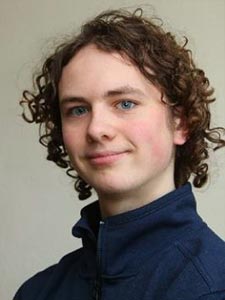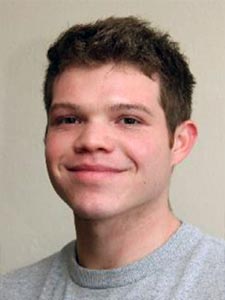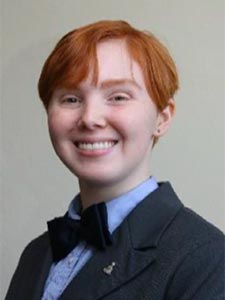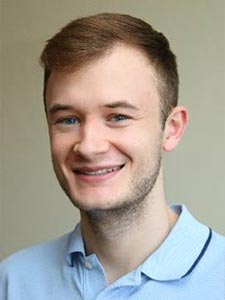 Joe Bean
Joe BeanHometown: Omaha, Nebraska
Major: Biology and Medicine
Faculty Mentor: Dr. Ryan D. Mohan
Mentor's Department: Biology
Funding Source: n/a
Regulation of the Sleep Cycle by an Unexpected Yet Common Biological Process
The sleep cycle, or circadian rhythm, is an important biological process conserved between many higher order animals. While it normally ensures that we sleep at consistent times day to day, this cycle can be inexplicably disrupted in a number of neurodegenerative diseases, including Parkinson's, Alzheimer's, Huntington's, and Spinocerebellar Ataxia-7 (SCA7)- the focus of our lab. Understanding what controls the circadian rhythm allows us to draw closer to ameliorating these sleep disturbances in individuals afflicted with such diseases. While researching SCA7 and some of the proteins that cause this disease, we found a common protein modification and control system- ubiquitination- to be changing with the circadian rhythm. Ubiquitination is a process wherein small proteins called ubiquitin are attached to a protein in order to initiate the break down of that protein. Further, it was found that flies with a mutation which affected their ability to regulate their ubiquitination process had abnormal circadian activity patterns. Our work suggests that ubiquitination serves to control the circadian rhythm, and provides a possible understanding for why many neurodegenerative disease may include sleep disturbances as secondary symptoms. By better understanding the circadian rhythm, we can come to a fuller understanding of these sleep disturbances and, eventually, the diseases that include them.
 Alexandra Cutter
Alexandra CutterHometown: St. Louis, Missouri
Major: Biological Sciences
Faculty Mentor: Dr. Leonard Dobens
Mentor's Department: Biology
Funding Source: n/a
Investigation of Structural Requirements for Proper Trafficking of Drosophila Tribbles
Using the model organism Drosophila melanogaster, otherwise known as a fruit fly, our lab is studying the gene Tribbles. Tribbles is a highly conserved pseudokinase that plays roles in cell migration, differentiation, proliferation, and metabolism. Previously, we mutated a unique, strongly conserved SLE motif and observed a strong redistribution of the protein from the nucleus to the cortex of larval fat body tissue with a concurrent increase in Trbl protein stability. In addition, structural work on human Trib1 suggest that this motif interacts with a conserved alpha C helix in the protein structure. This led us to design a complementary mutation on the alpha C helix we expected will mimic the SLE mutant phenotype. However, our alpha C helix mutants failed to copy the original phenotype. Going forward, we plan to design different alpha C helix mutants using online protein databases, structural analysis, and Tribbles sequence alignments. Further investigation of this phenotype will help us understand Trbl protein function, trafficking, and stability, possibly shedding insight on autoimmune and prion illnesses.
 Sami Gul
Sami GulHometown: Ankara, Turkey
Major: Political Science & Math
Faculty Mentor: Dr. Debra Leiter
Mentor's Department: Political Science
Funding Source: UMKC SEARCH Grant
How Do Education Levels Affect Public Perception of Corruption?
How does education level impact a person’s perception of corruption within their state? In this study, we draw on cross-national and cross-temporal survey data of 30 European states which was produced by the Inter-University Consortium for Political and Social Research (ICPSR) and Leibniz Institute for the Social Sciences (GESIS). We examine the relationship between education levels and perceived corruption in 24,276 responses. We find that there is a statistically significant negative relationship between a respondent’s level of education and the corruption that they perceive in their state. Moreover, we found that there is no significant effect of education on perceived political corruption.
 Anum Khalid
Anum KhalidHometown: Lee’s Summit, Missouri
Major: Psychology
Faculty Mentor: Dr. Oh-Ryeong Ha
Mentor's Department: Psychology
Funding Source: UMKC SEARCH Grant
The Effect of Self Regulation Development on Prosocial Decision Making of 5-8 Year Old Children
Children who have efficient and flexible self- regulation skills are more proficient in regulating their behavioral repertoire (Campos et al., 2004; Carver & Scheier, 2012; Eisenberg & Spinrad, 2004). Efficient self-regulation skills are related to a good quality of social interaction such as high interpersonal sensitivity and prosociality in adults (Lopes, Salovey, Cote, & Beers, 2005). In contrast, aggression and behavioral problems were negatively related to prosociality in young children (Yarrow et al., 1976). To better understand the effect of self-regulation development on young children’s prosocial behaviors, this study examined how children’s self-regulation development, indicated by emotional and behavioral competence, was related to prosocial decision-making in 5-8 year old children. It was hypothesized that children with higher behavior problems (inefficient self-regulation skills) are more likely to make more egocentric, less prosocial decisions.
 Brandon Landaverry
Brandon LandaverryHometown: Lee’s Summit, Missouri
Major: Environmental Engineering
Faculty Mentor: Dr. Caroline Davies
Mentor's Department: Geosciences
Funding Source: UMKC SUROP Grant
Characterization of Aeolian Source Material from the Al-Jafr Basin, Jordan Using Grain Size, X-Ray Diffraction, Geochemical Analysis and SEM
This research project characterizes the texture, morphology, composition, mineralogy and geochemical of dune sediments from the Al-Jafr Basin, Jordan. The research consists of the first dune samples to be analyzed from the largest basin on the Jordan Plateau. Using various analytical methods reveal the paleoenvironmental processes dominating landscape formation at this location. Microscope examination revealed presence of vegetation and fossils. Grain size results throughout the sand dune samples identified the sediment as predominately silt size particles, predominately fine silt. This indicates moderate and steady wind energy to transport these particles.
 Celine Lim
Celine LimHometown: Selangor, Malaysia
Major: Mechanical Engineering
Faculty Mentor: Dr. Sarvenaz Sobhansarbandi
Mentor's Department: Civil and Mechanical Engineering
Funding Source: UMKC SUROP Grant
Heat Transfer Enhancement of Phase Change Materials for Thermal Energy Storage Systems
Solar water heaters (SWHs) are a well-established renewable energy technology that has been widely adopted around the world. The most important component of the SWHs is the solar collector that absorbs the solar radiation from the sun and transfers it to some transfer medium such as water, which delivers the heat as hot water to a house or to a heat storage unit. Among different types of solar collectors, one example of an advanced and highly effective type of solar collector is the Evacuated Tube solar Collectors (ETCs). In the recent work of Dr. Sobhansarbandi, my supervisor and director of UMKC Renewable Energy Research Laboratory, a novel method of integrating phase change materials (PCMs) within the evacuated solar tube collectors for solar water heaters (SWHs) has been studied which show efficiency improvement of 26% for the normal operation and 66% for the stagnation mode, compared with standard solar water heaters that lack phase change materials. Phase change materials are latent heat storage materials. The thermal energy transfer occurs when the material changes from solid to liquid, or liquid to solid phase. By performing thermal analysis of PCMs, we are able to monitor their phase change process, as well as their thermophysical properties variation. In order to overcome the shortcoming of PCMs, we are planning to incorporate some materials with high heat transfer capacity and high thermal conductivity in conjunction with PCMs which can lead to a fast energy transfer to the PCM layers.
 Carrie Merritt
Carrie MerrittHometown: Archie, Missouri
Major: Environmental Science
Faculty Mentor: Dr. Fengpeng Sun
Mentor's Department: Geosciences
Funding Source: UMKC SUROP and Search grants, & NSF Mo Transcet/EPSCoR
Midwestern Climate Modelling and Analysis: An Examination of the Impact of Mitigation on Future Climate
This study is a continuation of Midwestern Climate Modelling and Analysis: An Examination of Climate Patterns, Trends, and Sensitivities. The aim of the study is to examine what the change could be globally, and in the Midwest, if humans made a collective effort through collaborations and agreements across countries to mitigate and reduce fossil fuel emissions (and other major sources of GHGs) by focusing on RCP4.5 temperature changes. This project will expand on the “business-as-usual” (RCP8.5) warming projections through comparative temperature change analysis for a “mitigation” GHG scenario (RCP4.5). The Fifth Assessment Report of the United Nations Intergovernmental Panel on Climate Change (IPCC-AR5) outlines four Representative Concentration Pathways (RCPs) that represent greenhouse gas (GHG) emissions. Phase one of this project demonstrated that the Midwest is sensitive to climate change and will see significant warming in the future. Examining the differences between the projected warming when humans do curtail GHG emissions and when we do not, will allow Midwesterners and policy makers to encounter the clear and concise facts that will represent what the Midwest may likely experience in our imminent future.
 Rhiannon Minster
Rhiannon MinsterHometown: Chesterfield, Missouri
Major: English
Faculty Mentor: Prof. Michael Pritchett
Mentor's Department: English
Funding Source: UMKC SEARCH grant
Wilden Arts High School: A Young Adult Novel
Much of young adult literature does not touch on the intricacies of high school life. For my first novel I wanted to create a realistically stressful environment for students in multiple artistic disciplines. I set my novel in Chicago and traveled there in March to see the fine art community for myself. While there I saw A Bronx Tale, the Chicago Symphony Orchestra perform Beethoven and Wagner, and visited several museums. With four main characters, all in different disciplines, I am able to show them from different angles and perspectives through the eyes of the other characters. All of them suffer different mental health problems, and for today’s teens, for whom suicide is the second-most common cause of death, it is vital to create a dialogue in which they can discuss their emotions. If a novel does not have a realistic environment or characters, then teens are easily able to avoid difficult topics rather than engaging with them.
At Wilden Arts High School (WAHS) in Chicago, the fall semester sees dozens of talented new students come to campus. Bassist Summer Fulk, pianist Mike Wang, actress Carrie Jackson, and actor Edger Smith all join a play produced by the Theater Club. Though they try to begin with a fresh start, none of them are able to leave their troubled pasts behind them.
Inspirations for this novel include Ferris Bueller's Day Off, The Breakfast Club, Your Lie in April, Your Name, Looking for Alaska, and The Fault in Our Stars.
 Samuel Nelson
Samuel NelsonHometown: Kansas City, Missouri
Major: Psychology and Economics
Faculty Mentor: Dr. Oh Ryeong Ha
Mentor's Department: Psychology
Funding Source: UMKC SUROP grant
The Effect of Stress in Eating Behavior
According to the Centers for Disease Control and Prevention, 70.7% of Americans over the age of 20 are overweight (National Center for Health Statistics, 2016). Being overweight can lead to a multitude of serious health complications; therefore, identifying risk factors for obesity is an important avenue for public health research. Stress has long been shown to be one of the factors that influences eating behavior (Wallis & Hetherington, 2004). To better understand the influence of stress on eating behaviors, my research explored how stress resulting from social exclusion influenced eating behavior. Participants used a computer program to make choices about food regarding taste, preference, health and consumption. In order to induce stress, participants were then asked to introduce themselves via a three-minute introductory video to a potential partner, who would either reject the participant or accept them as their partner. After the aforementioned stress induction procedure, participants made more food choices on the computer. Food choices from time one and time two were then compared.
Participants who were rejected by their partner chose to eat healthy and unhealthy foods less. Per the literature surrounding stress research, rejected participants were expected to eat more unhealthy foods; however, they demonstrated restricted eating behaviors after stress exposure. It was likely that the nature of the stress in this experiment, the stress stemming from the social rejection by first impression, might have guided the individuals to turn their attention inward, causing them to self-consciously restrict their eating.
 Vyo Ngn
Vyo NgnHometown: Kansas City, Missouri
Major: Chemistry
Faculty Mentor: Dr. Ryan Mohan
Mentor's Department: Biological Sciences
Funding Source: UMKC SUROP & SEARCH grants
Drosophila Flies’ Brains Might Help Save Humans with Spinocerebellar Ataxia
The project we are doing research on helps to find more information about Spinocerebellar ataxia (SCA), a neurodegenerative disease caused by mutations in DNA, affecting patient’s movement and tend to get worse over time. There are many types of spinocerebellar ataxia found in humans, each affecting distinct sets of neurons. SCA 7 is a type of spinocerebellar ataxia, but it results in visual problems rather than poor body coordination. In statistic, the disease affects more than 150,000 people in the U.S., included Missouri. There’s no cure for this disease yet due to the lack of information about the mechanism behind the disease. In the lab, we use drosophila models to reveal insights into mechanism underlying neurodegeneration. My responsible in the lab is to perform the circadian entraining project on the flies and performing dissection on flies’ brains. Through my work, flies’ brains were harvested for immunofluorescence. The images reveal the amount of proteins in wild type flies. Once we understand how the amount of the protein in the wild type flies fluctuate throughout specific time of the day, we can compare the data to the mutant types to find some results.
 Hannah Nguyen
Hannah NguyenHometown: Kansas City, Missouri
Major: Biology
Faculty Mentor: Dr. Rachel Allen
Mentor's Department: Biological Sciences
Funding Source: UMKC SEARCH grant
Mammalian Comparative Anatomy of Larynges and Their Correspondence to Various Sounds Produced
This study focuses on comparing the physical anatomy of the larynx across different mammals, such as felines, canines, bovine, and more. A bulk of the mammals are typically sourced from farms. Given that the larynx is one of the principal players to producing sound in a mammal, including humans, this motivates one to determine what morphological characteristics of the given animal’s larynx correspond to the cry or sound they produce. Few studies have focused on the shape of a mammal’s larynx that help govern the sound the animal creates. Of the available studies to help guide this research, credits are given to the following authors with their respective works: Saigusa (Comparative Anatomy of the Larynx and Related Structures), D. F. N. Harrison (The Anatomy and Physiology of the Mammalian Larynx), Saachi, et. al. (Larynx Morphology and Sound Production in Three Species of Testudinidae), and many more. Given this literature has helped inform, guide, and shape this study on the morphological characteristics and functional understanding of the larynx and how its performance varies on different mammalian species. By conducting this study, one can appreciate the shape and size of a mammal’s larynx to determine what kind of sound they produce.
 Minh Nguyen
Minh NguyenHometown: Kansas City, Missouri
Major: Biology
Faculty Mentor: Dr. Ryan Mohan
Mentor's Department: Biological Sciences
Funding Source: UMKC SUROP & SEARCH grants
Experiment on the Biotechnique: The Game Changer
Spinocerebellar ataxia is a genetic disease affecting about 150,000 people in the United States. There are many types of spinocerebellar ataxia found in humans, each affecting distinct sets of neurons. Spinocerebellar ataxia type 7 leads to degeneration of the retina and cerebellum of patients, resulting in blindness and loss of motor control. On a molecular level, this disease is characterized by expansion of CAG trinucleotide repeats in the ataxin 7 gene, leading to an expanded polyglutamine tract at the N-terminus of the Ataxin-7 protein. Ataxin-7 is part of the larger Spt Ada Gcn5 Acetyltransferase (SAGA) chromatin modifying complex. Here it uses its N-terminus to anchor a deubiquitinase enzyme called Non-stop to SAGA. However, in SCA7 the polyglutamine expansion may disrupt this interaction. In the Mohan laboratory, we use Drosophila melanogaster as a model system to understand the normal function and regulation of Ataxin-7 and Non-stop so that we can understand what processes are misregulated in SCA7 disease, potentially leading to the identification of a drug target. Part of understanding function requires knowledge of where Ataxin-7 and Non-stop are in the brain. My role in the Mohan lab is to find out which biotechniques work best to keep the brains form stable in determining the subcellular and sub-neural localization of Ataxin-7 and Non-stop using immunofluorescence. We dissect larval brains of Drosophila, let the brains stay in blocking buffer containing BSA. I apply different techniques: slow freeze, fast freeze and basic technique. Each technique has a specific way of keeping the brains in blocking buffer. Then I stain the brains with primary antibody, then stain with secondary antibody. Finally, we use a confocal microscope to do imaging. Then based on the images, we determine to see which biotechnique work best.